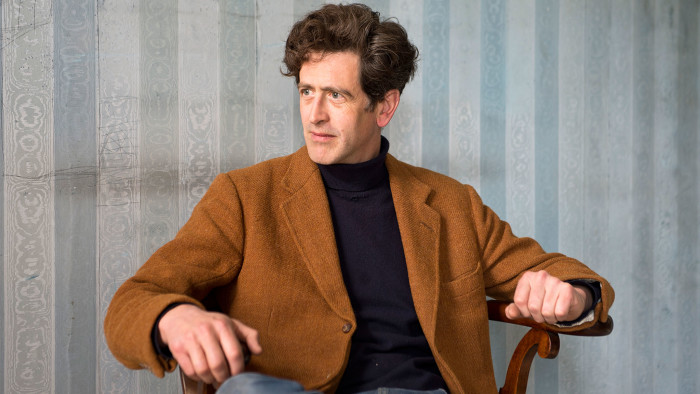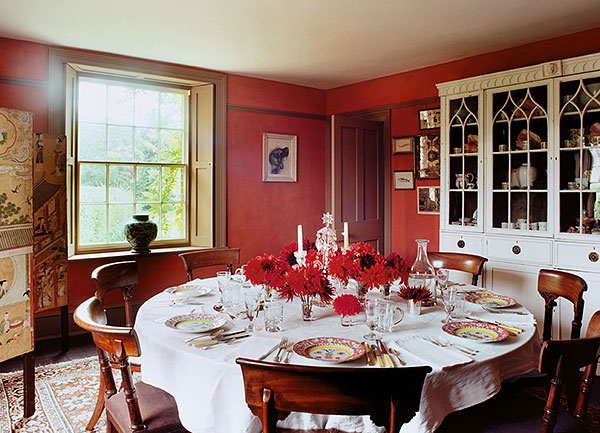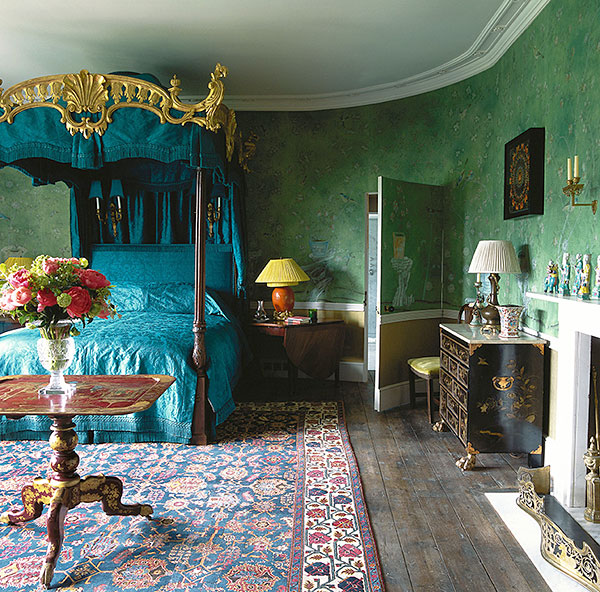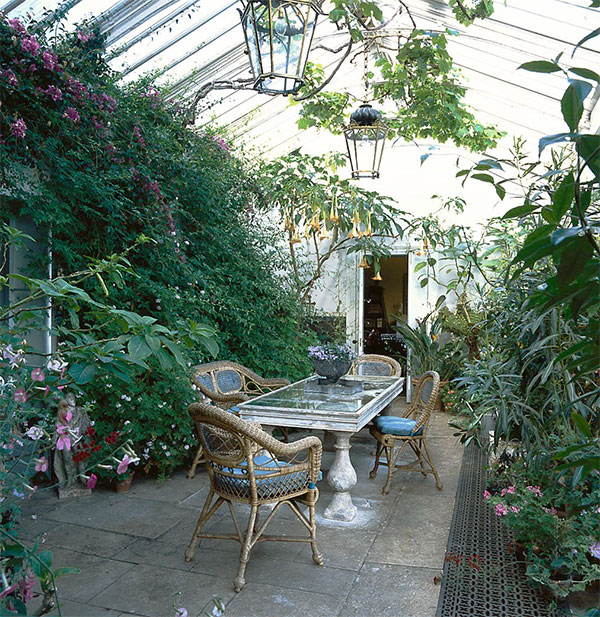Antique dealer Edward Hurst and the art of finding treasures

Simply sign up to the Life & Arts myFT Digest -- delivered directly to your inbox.
Edward Hurst wears a minor expression of worry, tinged with a diffident smile, at all times — but in the week before Masterpiece London the worry can take over. The pre-eminent antiques dealer of his generation — with a client list that includes Jasper Conran, Evgeny Lebedev and Lady Rothermere — Hurst puts his heart, soul and intellectual passion into the creation of his annual stand at Masterpiece; a stellar show in the already crowded firmament of the London summer design season.
Alongside dealers there such as Rose Uniacke — who, like him, cross the delicate line between antique selling and interior decoration — Hurst has built his reputation with these Masterpiece stands. Two years ago, he brought to the world a rare and fine William Kent hall bench, in perfectly untouched condition, en suite to the Hall furniture at Holkham, the great Palladian house on the north Norfolk coast. A bidding war ensued and the piece found its eventual new home at the Museum of Fine Arts in Houston.
Last year, Hurst’s fair piece was a Rococo clock, made for Frederick, Prince of Wales, which Edward had discovered in a regional auction catalogue — tarnished jet black. He knew he had found something special but only when it was cleaned and restored, and he had established its extraordinary royal provenance, did its full splendour shine. The clock was the talk of last year’s Masterpiece, and is now owned by the V&A.
How does this diffident, shy character work such magic? “I suppose,” he says, “that I have dealing in my bones . . . and I am on a journey that continues every day but began when I was five or six — about the age that I learnt to ride a bike.” It was then that Hurst first remembered holding old objects very tightly in his small hands, as if by doing so he might be able to travel in time — but always backwards: even then he had little interest in the future. In these objects he discovered a romantic longing that encapsulated in a moment the whole history of Britain. Today, of course, the objects are far rarer and more special, but the romance of the young time traveller still abounds.
A little later, on family holidays to the north Norfolk coast, Hurst began buying antiques — and, aged 12, started to sell them. He describes that early thrill of finding special things, an emotion which stays with him to this day; in fact, as his reputation grows in stature, it is the thrill factor that is increasingly the most important in deciding whether something is right or wrong. Without the heartbeat, he moves on.

Hurst’s father is a horological collector, and through him the young Edward was introduced to a network of some of the best antique dealers in the country. One, Robert Foulkes, started buying regularly from the teenage Edward. At 18 he left Oundle School with less than excellent results and became Foulkes’ junior partner in his shop in Nettlebed, a village not far from Henley-on-Thames. Ten months later, Foulkes died suddenly, and the business was left to Hurst. “I dealt in Romantic wrecks,” says Hurst, “where the vision and the object were pre-eminent. A chair may have collapsed when you sat on it, but the important thing was it was a unique piece.”
Christopher Gibbs, the doyen of London antique dealers, became a regular visitor, and Hurst quotes him as a huge influence — a gauge on whether an object should be bought today: what would Christopher think?
Hurst remained in Nettlebed for two more years, working out his aesthetic, before moving to a small house in Salisbury with 17th-century panelled rooms and space for a shop.
Axel Vervoordt, the Belgian interior designer, became a customer, and Hurst, in turn, stayed with Axel and his wife, learning from their powerful aesthetic — which like Gibbs’s, wore academia lightly and placed great importance on the visual, romantic and associational value of the object itself, and on the aesthetic combination of differing objects. Taste, and a powerful visual identity, was being nurtured in the small panelled enclaves of Salisbury.

Hurst met and married Jane, and a few years later they moved to Coombe Bissett, a tiny village in the heart of Wiltshire, and together they created a remarkable house and garden there. They have now moved to a dreamy house in Dorset where they are restoring the interiors slowly and Jane is planting a beautiful garden.
When, in 2006, the Marquess of Salisbury, Robert Gascoyne-Cecil and his wife Hannah, took up permanent residence at Hatfield, that great Jacobean trophy house to the north of London, they gave Hurst a loose commission to help breathe new life into the splendid King James Drawing Room and other staterooms. Alec Cobbe was supervising the rehang of the paintings, and Hurst attests to learning from Cobbe’s knowledge, historical sensibility, and dramatic sense of stage setting. Hurst was responsible for juggling the furniture around, and, here and there, sourcing and buying key pieces where gaps remained to be filled. He found fabrics for reupholstery and generally worked his magic, but all the time, as he puts it “never hitting things hard . . . just making the gentlest touch in a few rooms”.
In 2006 Edward and Jane’s house at Coombe was published in the bible of British decoration, The World of Interiors, and so began a long and well-known association between Hurst and that powerful tastemaker, Jasper Conran — who was continuing his own long love affair with the romance of old houses with the recent purchase of a Baroque gem in Somerset, Ven House. Conran saw Hurst’s house in the magazine and knew that here was someone who shared his vision and could make it real.

“To be given the chance to play with no deadline, and no pressure,” says Hurst, “was wonderful. Every Friday Jasper and I would meet and discuss the week’s findings . . . and together we breathed life back into the old bones of Ven — although of course,” he adds, “English Baroque is the hardest of all to decorate”.
Still today, Hurst shies away from the term interior decorator, because he does not see this as his role. It is in finding furniture, rugs, lighting, fabrics and objects that have historical resonance and chime together that he weaves his magic. There are no “schemes”, and no instantly put-together creations. Everything is gently baked in a very slow oven, ingredients added in response to flavours already emerging. When Conran, a few years later, purchased one of the finest examples of English Neo-Classicism, Wardour Castle, he again turned to Hurst for assistance, and their creative adventures continued. Mutual friends have turned to Hurst, although he now has a waiting list as he remains an almost one-man band. At Stud House in Hampton Court, he has collaborated with the polymath and decorator Patrick Kinmonth, in creating — for Evgeny Lebedev — one of the finest sets of rooms in this country in the past few decades. The attention to detail is mind-boggling, the result spectacular.
More recently, the new Earl and Countess of Shaftesbury, reoccupying their great Dorset mansion, St Giles House, 50 years after the family deserted it, found the perfect collaborator in Hurst, who understood instinctively the drowsy, sleepy, untouched qualities of place that they wished to preserve and enhance.

And last year, Hurst embarked on an even more interesting collaboration, with Claudia Rothermere at Ferne Park, the remarkable classical house and garden that she has orchestrated on the borders of Dorset and Wiltshire. Together they have conceived a new building in the grounds, a thatched stone house that is intended — back to the pure romance of history again — to feel like a fragment of a much larger early 17th-century manor house.
Hurst has designed and sourced everything down to the coat hooks and the china in the kitchen cupboards. This move into architectural design is exciting, and one wonders what gems may lie ahead if further commissions follow?
As the limousines purr up to the gates of the Royal Hospital, Chelsea, and lines of Masterpiece patrons with serious cheque books swell, and as well-heeled shoes step into the softly carpeted aisles on the expectant search for the most special treasures . . . well, there is no place on earth that anyone there would rather be at this moment than at the centre of opening night of Masterpiece.

Beyond lengthening queues for champagne (the British art world will never completely pull off the fine art of being slick), and past the stands with bright and shiny contemporary furniture destined for the drawing rooms of Moscow, New York or Beijing, and behind academic dealers with perfectly matched pairs of perfectly polished Georgian chairs, tables and mirrors, we find Hurst — unassuming, terrified he’s forgotten something vital, but always with something romantic and powerful. This year it is an “Egyptomania” Regency daybed in the shape of a crocodile, in perfect condition.
His Masterpiece manner is unfeigned ignorance of the most famous of customers; one year, he spent half an hour talking earnestly to a beautiful but unrecognised woman, who was asking intent and intelligent questions about various pieces.
He asked if she would write down her details. Only later, rereading his notebook, did he realise he’d been talking to an acclaimed Hollywood actress.
This is Hurst’s skill and his power. He’s less interested in names than in things. And like a rare and elusive butterfly, that is the quality that all true collectors seek.
Ben Pentraeth’s next book, ‘English Houses’, will be published by Ryland Peters and Small and features Edward and Jane Hurst’s Dorset home
Photographs: Tim Beddow/The World of Interiors; Simon Upton/The World of Interiors; Dave Gibbons
Comments